How To Install Furnace Filter Rack
Proper Installation of Furnace and Air-Handler Filters
Telescopic
Install air filters on any ducted heating and cooling systems to filter air passing through the return air duct and outdoor air that is mechanically supplied to the air handler.
- Locate the filter where it can exist hands accessed by the homeowner for replacement or cleaning.
- If the filter is installed in a filter media box attached to the air handler, the access panel for the filter should be fitted with a flexible, air-tight gasket to prevent air leakage.
Encounter the Compliance Tab for related codes and standards requirements, and criteria to meet national programs such equally DOE's Zippo Energy Ready Home program, Energy STAR Certified Homes, and Indoor airPLUS.
Description
Air filters are an important component of forced air HVAC systems. Filters are installed on the render side of the HVAC air handler to clean the air to protect the HVAC motor and to improve indoor air quality. Filters should also be installed in fresh air intakes to make clean outside air that is brought into the home. Filters with college MERV (Minimum Efficiency Reporting Value) ratings of MERV 6 or above tin trap pollutants like pollen, grit mites, and mold spores. However, a dirty, chock-full filter tin can dramatically reduce air menses, increasing furnace run time and increasing both habiliment on the motor and energy consumption. For optimum performance of both the filter and the HVAC equipment, the filters should be replaced or cleaned frequently. Therefore, the filters should be located in a identify that is easily accessible for the abode owner.
If the furnace air handler is in an accessible location (such equally a utility room, a basement, or an cranium with a pull-down staircase), the filter can be installed in the air handler at the render plenum. The air handler box should be equipped with a filter media box that has a removable access panel cover that has a gasket for an air-tight seal when closed. The filter box might be prefabricated by the manufacturer or could be fabricated on site. The filter media frame should be appropriate for the size and type of filter desired. The filter dimensions and filter depth both influence filter chapters and air catamenia velocity. Filter sizing must be taken into account when designing the HVAC system to ensure that the HVAC system can handle the associated pressure drop, especially with high MERV filters. Increasing the filter surface area will decrease pressure drop; options for increasing surface expanse could include using more deeply pleated filters or larger dimensioned filters. Filters must be sized using the Air Conditioning Contractors of America (ACCA) Manual D (ANSI/ACCA 2009). For more information on furnace filter types, MERV ratings, and sizing, see the guide Loftier MERV Filter.
If the furnace is in the attic, the attic should exist equipped with a staircase or pull-downward stairs and a permanently installed walkway that the homeowner or service technician can employ to get to the furnace.

If the furnace air handler is located in an inaccessible location such every bit a crawlspace or attic without a staircase, then the furnace filters should be located in the return grilles, with a filter located in each return grille.
If the home is equipped with a fresh air intake that is ducted to the air handler, a filter should exist installed at the fresh air intake and the fresh air intake should exist located where information technology is accessible so the filter can be replaced or cleaned as needed.
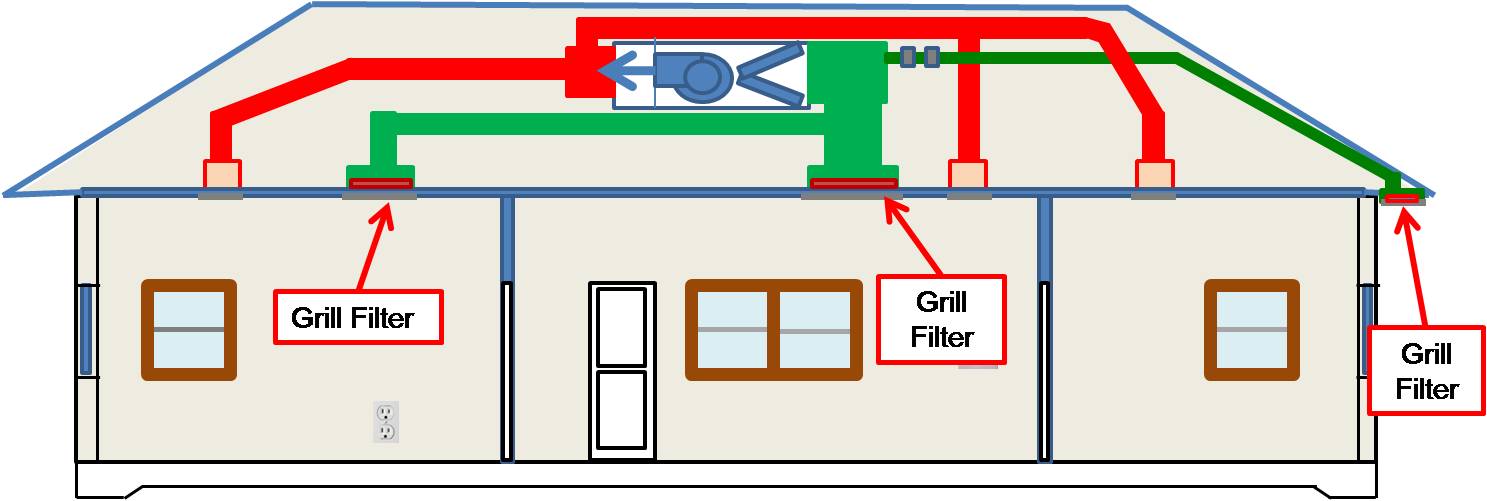
How to Install a Filter in a Furnace Air Handler
1. Fabricate and install a filter media box on site. Install the filter media box between the return air plenum and the air handler box. Or, buy an air handler that includes a pre-fabricated filter box. Ensure that the box is the right size for the filter to be installed. Filters must be sized using ACCA Manual D (ANSI/ACCA 2009). Improperly sized filters can cause mechanical failure.
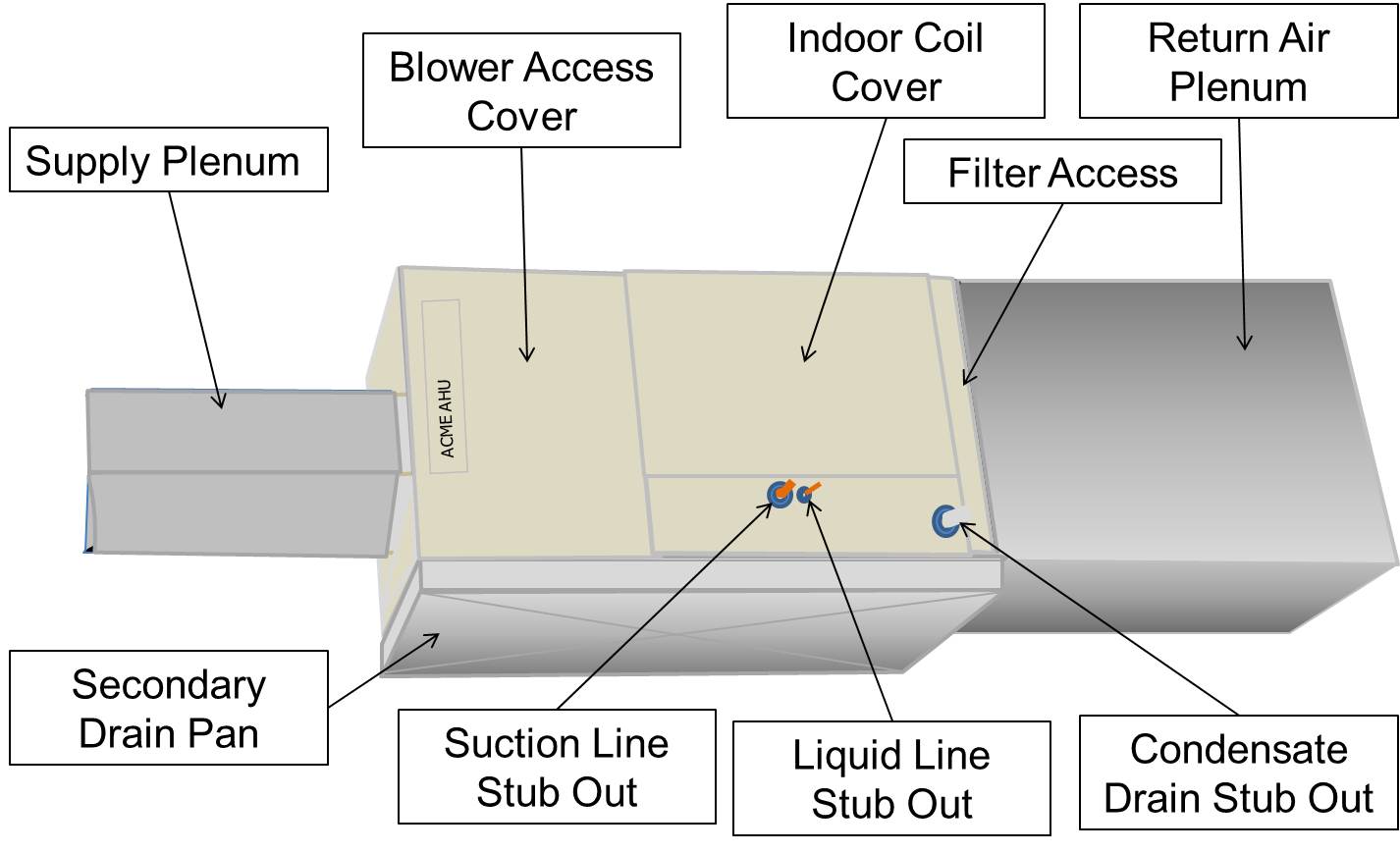
2. Slide the filter into the slot and identify the filter access panel encompass over the opening. The panel cover should have a gasket to ensure an air-tight seal. The embrace tin exist fastened at the edges with duct tape or magnetic tape, which provides additional air sealing and tin be easily removed when the filter is checked for cleaning or replacement. If the filter encompass is left off or unsealed, the air handler can pull unconditioned and/or unwanted air into the home. Leakage at the filter cover can contribute to poor indoor air quality if the air handler is located in a garage or other areas where the air quality is not desirable.
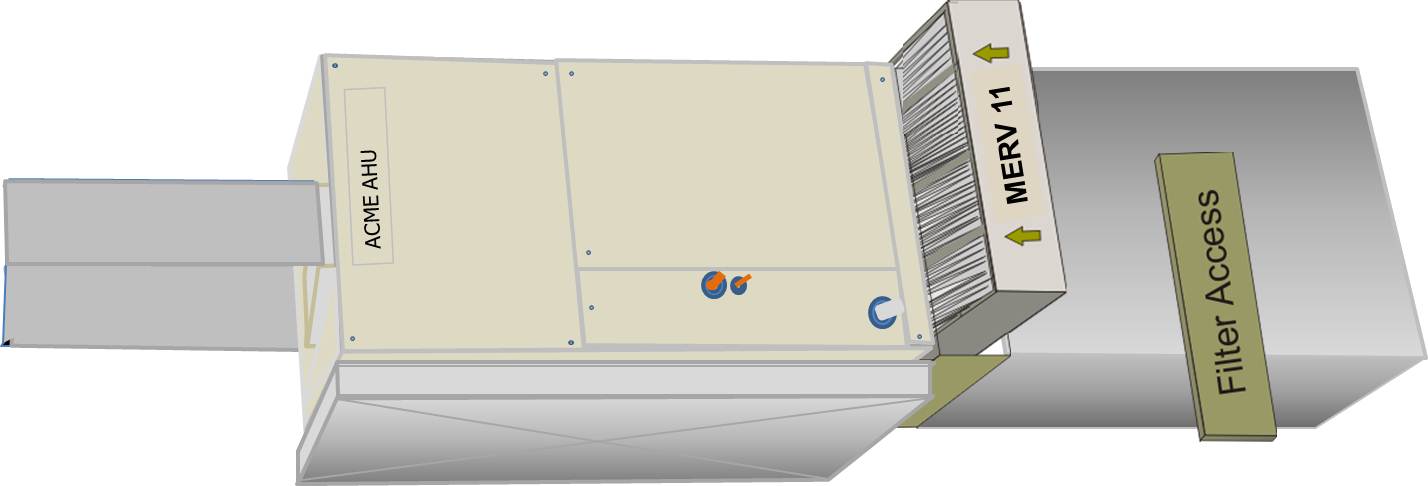
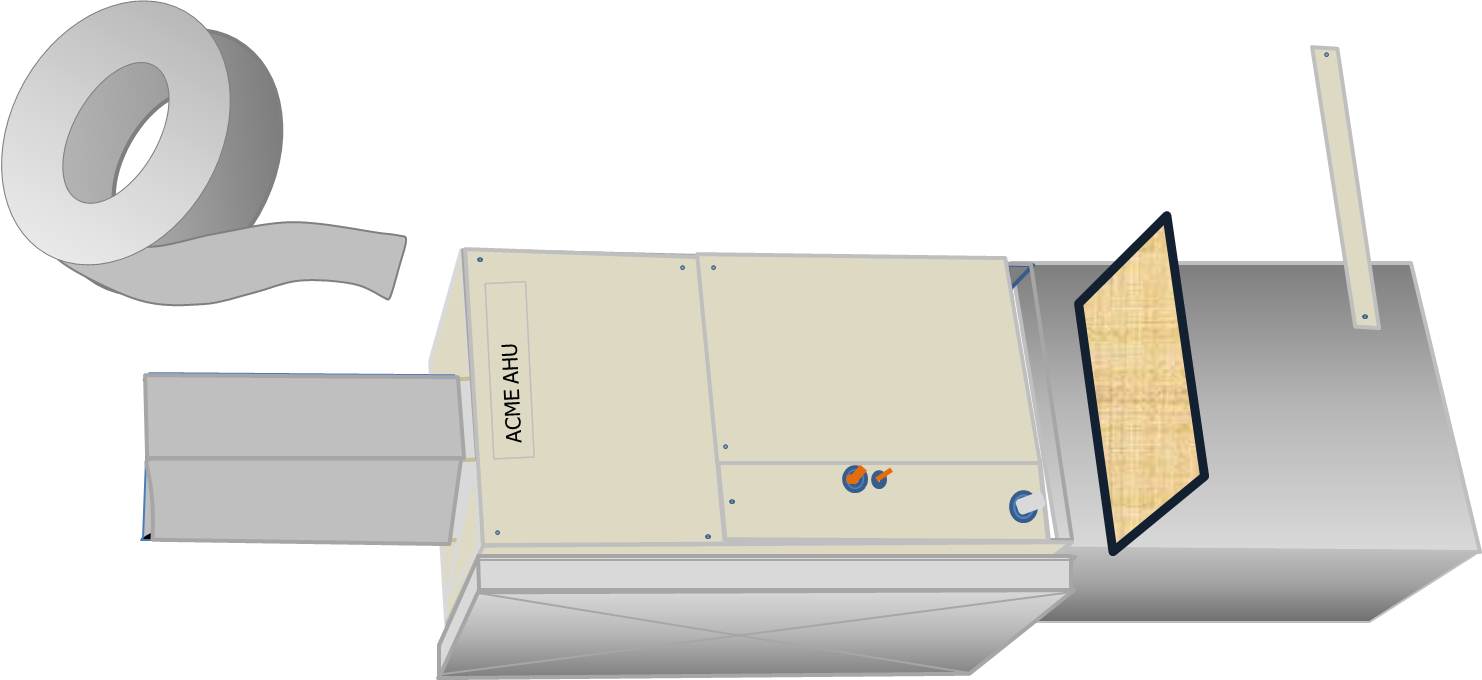
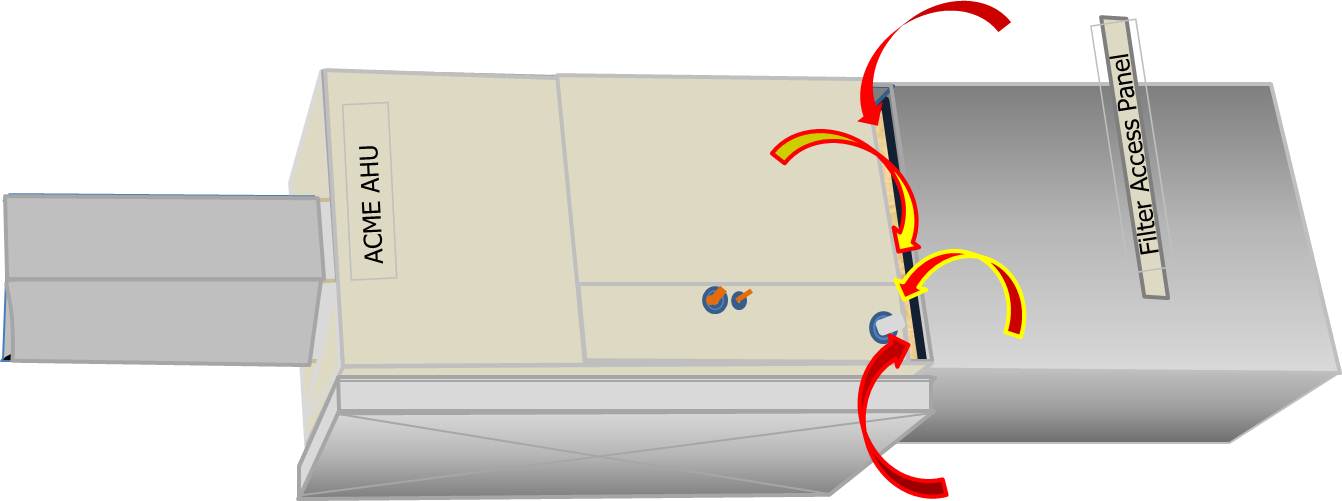
iii. Complete air handler installation by installing wiring and condensate piping. Ensure that piping and wiring practise not block access to the filter.

How to Install a Filter at the Return Grille
1. If the furnace is in a location that is difficult for the homeowner to access (for example, a crawlspace or an attic that does non have stairway or drop-down stairway access), then install filters inside the return grilles in the home.
2. Ensure that grilles can be opened from within the home. Install grilles that can be removed safely, for example, grilles that are attached by a hinge along 1 side to minimize the chance that they will accidentally fall down while being opened.

3. Install MERV vi or higher filters that match the sizing designation specified by the HVAC designer in accordance with Manual D (ANSI/ACCA 2009). Practice not install filters with MERV ratings college than that for which the HVAC system was designed. Higher-than-specified MERV filters will increase air resistance, increasing energy usage and possibly contributing to equipment failure. For more about filter sizing, see High MERV Filter.
How to Install a Filter at the Fresh Air Intake
-
Choose a location to install the outside air intake, such as a porch ceiling or eave, that is away from polluting sources and easily accessible to the home possessor to facilitate filter replacement (see Figures 2 and 9). For more on exterior air intake locations, see Ventilation Air Inlet Locations.
-
Cut a hole for the air intake with dimensions similar to the grille and the filter to be installed. When selecting a filter size and MERV rating, consider air flow resistance because the pressure drop of this outdoor air intake duct and filter must be included in the Manual D calculations when designing the entire HVAC duct arrangement. A MERV 6 filter should be adequate.
-
Install a annals box (boot) to which the duct will be attached. Most annals boxes are at to the lowest degree 4 inches deep. This infinite will go on the duct terminus from touching the filter. Allowing several inches of distance betwixt the filter and the duct terminus helps to decrease the velocity of the air menstruum through the filter and likewise ensures that the full surface area of the filter is used, which volition improve filter performance and increase filter life.
-
Install a hinged grille at the exterior of the fresh air intake opening (see Figure eight).
-
Install wire mesh insect and bird screen.
-
Place the filter on the interior side of the grille and close the grille.
-
Include instructions informing the homeowner to check this filter periodically for replacement with a similar MERV-rated filter.
-
If the outside air intake must be located in an inaccessible location, construct and install a filter media frame in a filter box that is positioned in an accessible place at the duct connection to the air handler return air plenum or somewhere along the fresh air intake duct that is accessible to the home possessor.

Ensuring Success
In homes with ducted HVAC equipment, the HVAC contractor should specify and install furnace filters at the return plenum of the air handler or at all return grilles and on whatever outdoor air intakes. The HERS rater should audit to make certain that the filters are installed correctly. If the filter is installed at the furnace, inspect that a filter media box has been installed to business firm the filter and that this box has an access panel with a gasket to forestall air leakage.
Climate
No climate-specific information applies.
The Compliance tab contains both program and code information. Code language is excerpted and summarized below. For exact code language, refer to the applicative code, which may require purchase from the publisher. While we continually update our database, links may have changed since posting. Delight contact our webmaster if you find broken links.
ENERGY STAR Certified Homes, Version three/three.1 (Rev. 09)
National Rater Field Checklist
9. Filtration
9.one At least one MERV vi or higher filter installed in each ducted mechanical system in a location that facilitates access and regular service by the owner.53
9.2 Filter admission panel includes gasket or comparable sealing mechanism and fits snugly against the exposed edge of filter when closed to prevent featherbed.54
nine.3 All render air and mechanically supplied outdoor air passes through filter prior to workout.
Footnote 53) Based upon ASHRAE 62.ii-2010, ducted mechanical systems are those that supply air to an occupiable space with a total amount of supply ductwork exceeding x ft. in length and through a thermal workout component, except for evaporative coolers. Systems that do not encounter this definition are exempt from this requirement. While filters are recommended for mini-split systems, HRV'south and ERV's, these systems, ducted or not, typically practice not have MERV-rated filters available for use and are, therefore, as well exempted under this version of the requirements. HVAC filters located in the cranium shall be considered accessible to the occupant if either 1) drop-down stairs provide access to attic and a permanently installed walkway has been provided between the attic access location and the filter or 2) the filter location enables arm-length access from a portable ladder without the need to step into the cranium and the ceiling height where admission is provided is ≤ 12 ft.
Footnote 54) The filter media box (i.due east., the component in the HVAC arrangement that houses the filter) may be either site-fabricated past the installer or prefabricated by the manufacturer to meet this requirement. These requirements only apply when the filter is installed in a filter media box located in the HVAC system, not when the filter is installed flush with the return grill.
Please run into the Energy STAR Certified Homes Implementation Timeline for the program version and revision currently applicative in in your state.
DOE Zilch Energy Ready Dwelling house (Revision 07)
Exhibit ane Mandatory Requirements.
Showroom one, Item i) Certified under the Free energy STAR Qualified Homes Programme or the ENERGY STAR Multifamily New Construction Program.
Exhibit one, Particular vi) Certified under EPA Indoor airPLUS.
EPA Indoor airPLUS (Revision 04)
4.7 Filtration for Central Forced-Air HVAC Systems. Install only HVAC filters that are rated MERV eight or college according to ASHRAE 52.ii-2007 (at approximately 295 fpm).
Advisory: EPA recommends, but does not require, filters rated at MERV thirteen or higher to reduce exposure to fine particles. Filters perform best when the filter rack pattern includes the post-obit features, which are also included in some manufacturers' filter media boxes:
- Flexible, air-tight (e.g., airtight-prison cell cream) gasket material on the surface that contacts the air-leaving (downstream) side of the filter.
- Friction fit or spring clips installed on the upstream side of the filter to hold information technology firmly in place.
- Upon installation of the air handling unit of measurement, include a filter for the remainder of construction action to protect the unit of measurement and/or gyre from construction debris and dust. Filter should be clean upon final inspection following structure (see Specification seven.1). Advisory: To reduce the likelihood of construction grit contaminating the ducts and air handler, limit use of the HVAC system during activities with increased dust (e.g. drywall sanding, floor sanding).
- Practise not install whatever air-cleaning equipment designed to produce ozone (i.e., ozone generators).
2017 California Championship 24 Building Free energy Efficiency Standards
The 2017 California Title 24 Edifice Free energy Efficiency Standards require all HVAC filters to be MERV 6 or greater. Filter media that provide at to the lowest degree l% particle efficiency in the iii.0- to 10-µm range co-ordinate to AHRI 680 are considered to meet the MERV 6 benchmark. HVAC filters are required to conform to the design pressure driblet specification on the return grille label.
2017 California Appliance Efficiency Emergency Rulemaking for Residential Air Filters
The California Energy Committee has proposed to meliorate the California Code of Regulations, Championship 20, Sections 1606, Tabular array X, and 1607(d)(12) to delay the date past when residential air filters for use in forced-air heating or forced-air cooling equipment that are sold or offered for sale in the State of California must comply with the mandatory testing, certification, and mark requirements in the appliance efficiency regulations, from July 1, 2016, to Apr one, 2019.
American Lung Association
The American lung Association Health House® guidelines require filters to have a minimum rating of MERV 11 (ALA 2012).
American Society of Heating, Refrigeration and Air Conditioning Engineers (ASHRAE) Standard 52.2-2017 - Method of Testing General Ventilation Air-Cleaning Devices for Removal Efficiency by Particle Size
Standard 52.2 establishes a method of laboratory testing to measure the performance of full general ventilation air-cleaning devices in removing particles of specific diameters.
ASHRAE Standard 62.1-2016 –Ventilation for Adequate Indoor Air Quality
ASHRAE Standard 62.1 sets specifications and measures for ventilation organization design and indoor air quality.
ASHRAE 62.ii-2010, ASHRAE 62.2-2013, and ASHRAE 62.2-2016
ASHRAE Standard 62.2 sets specifications and measures for ventilation arrangement design and indoor air quality in low-rise residential buildings.
American National Standards Institute (ANSI)/Ac, Heating and Refrigeration Found (AHRI) Standard 680, 2009 Standard for Performance Rating of Residential Air Filter Equipment
Standard 680 establishes definitions, classifications, test requirements, data requirements, ratings, operating requirements, mark and nameplate information and conformance conditions for residential air filter equipment.
Existing Homes
SCOPE
Supersede the air filters in ducted heating, ventilation and air-workout (HVAC) equipment with new filters having a MERV rating of half-dozen or college and a resistance to airflow that does non exceed the commanded pressure drop for the HVAC system.
- Check the condition of the HVAC filters. If the filters are loaded with particulates, replace with new, higher MERV filters when performing HVAC-related habitation performance upgrades and when responding to condolement complaints. Make sure the new filters do not exceed the immune pressure drop for the HVAC arrangement.
- If the homeowner requests a loftier-MERV (or HEPA) filter, verify the pressure drop will still be within acceptable limits.
- Provide homeowners with information for futurity filter replacement, such every bit the date of the next filter replacement, designed pressure drop for the filter, and installation instructions.
- Follow condom work practices as described in the U.S. Department of Energy's Standard Work Specifications when replacing and handling HVAC filters and inspecting air handlers.
DESCRIPTION
How to Install and Specify High-MERV Filters in an Existing Home
- At the HVAC equipment, identify the return grille characterization, if available. Write downwardly the initial resistance (inches water column, inch west.c.) of the HVAC filter at the pattern airflow rate (cubic-anxiety per minute, cfm).
- Go to each HVAC filter location and write down the dimensions of the existing filters. If there are air gaps around whatsoever of the filters, then use a measuring tape to determine the advisable dimensions.
- When purchasing or ordering new HVAC filters, use the resistance-to-airflow specified on the return grille characterization to purchase a replacement with the appropriate resistance-to-airflow. If the return grille label doesn't exist and specified filter resistance-to-airflow for the HVAC equipment is unavailable, try to determine the resistance-to-airflow of the spent filter (either on the filter, or via internet or retail sales person). If no information is available for the resistance-to-airflow, consider purchasing the same or a similar model of HVAC filter as the spent filter. Use the filter dimensions yous've written downward to ensure the replacement is the proper size. Identify filters with a MERV rating of vi or higher. If possible, select a filter with the static pressure measurements listed on the packaging or online.
- Once you've acquired new HVAC filters, note the installation date and recommended replacement engagement on the edge with permanent marker so the homeowner can rail the replacement wheel. Also note the MERV level and the specified air filter resistance-to-airflow if these are not already printed on the filter.
- Turn off the HVAC equipment or set up the thermostat so it won't operate while replacing the filters.
- Remove the spent filters from the ducted HVAC equipment.
- When installing the new HVAC filters, remove the plastic wrap but do not remove the cardboard framing. Place the airflow arrow and align the filter and so the arrow points toward the HVAC equipment in the render duct or return register grille.
- Insert the HVAC filter into the designated slot.
- Restore any levers, gaskets, seals, or grilles to their advisable condition.
- Turn the HVAC equipment dorsum on or render the thermostat to the appropriate temperature.
- Contractors, show homeowners how to supplant their HVAC filters and advise that they be replaced every three months, or more than oft if needed, especially in homes with HVAC equipment that runs half-dozen to twelve months per year, with 4 or more occupants, pets, smoking indoors, allergic occupants, or construction taking place within or outside the home. Show the homeowner the installation appointment and recommended replacement engagement noted on the filter frame.
- Contractors, advise homeowners to bank check HVAC filters periodically. Filters should be replaced immediately if the filters are clogged with debris, take collapsed fins, are making a banging noise when the system comes on, or are damp or moldy.
Access to some references may require buy from the publisher. While nosotros continually update our database, links may take changed since posting. Please contact our webmaster if you lot find broken links.
References and Resources*
*For non-dated media, such as websites, the date listed is the date accessed.
Contributors to this Guide
The following authors and organizations contributed to the content in this Guide.
Mobile Field Kit
The Building America Field Kit allows you to salvage items to your profile for review or use on-site.
Sign Up or Log In
Did y'all observe this information helpful?
How To Install Furnace Filter Rack,
Source: https://basc.pnnl.gov/resource-guides/proper-installation-furnace-and-air-handler-filters
Posted by: hernandezplingers.blogspot.com


0 Response to "How To Install Furnace Filter Rack"
Post a Comment